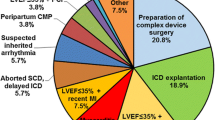Summary
Appropriate and inappropriate therapies of implantable cardioverter defibrillators have a major impact on morbidity and quality of life in ICD recipients. Intracardiac electrograms (IEGMs) stored in the ICD have been shown to be essential for differentiating appropriate and inappropriate ICD therapies. The recently introduced third generation of ICD Home Monitoring offers remotely transmitted IEGMs (IEGM-online). Hence, the appropriateness of ICD therapies might be remotely assessed. Validation of these electrograms is currently being performed in the RIONI study. A total of 210 episodes will be collected by about 40 European clinical centers. The study primarily investigates whether the IEGM-online based evaluation of the appropriateness of the ICD’s therapeutic decision following a tachyarrythmia episode detection is equivalent to the evaluation based on the complete ICD episode holter. The evaluation is independently performed by an expert board of three experienced ICD investigators. The equivalence of the two methods is accepted if the conclusions deviate for less than 10% of all evaluated IEGMs. Secondary endpoints investigate the IEGM-online usefulness in more detail. The conclusion of the study is expected by mid of 2007.
RIONI has successfully been started for proving the reliability of IEGM-online. The expected results will significantly influence the efficacy of Home Monitoring based patient management.
Similar content being viewed by others
References
Bänsch D, Steffgen F, Grönefeld G, Wolpert C, Böcker D, Mletzko RU, Schöls W, Seidl K, Piel M, Ouyang F, Hohnloser SH, Kuck KH (2004) The 1+1 trail: a prospective trial of a dual- versus a single-chamber implantable defibrillator in patients with slow ventricular tachycardias. Circulation 110:1022–1029
Bardy GH, Lee KL, Mark DB, Poole JE, Packer DL, Boineau R, Domanski M, Troutman C, Anderson J, Johnson G, McNulty SE, Clapp-Channing N, Davidson-Ray LD, Fraulo ES, Fishbein DP, Luceri RM, Ip JH (2005) Amiodarone or an implantable cardioverter-defibrillator for congestive heart failure. N Engl J Med 352:225–237
Cleland JGF, Daubert JC, Erdmann E, Freemantle N, Gras D, Kappenberger L, Tavazzi L (2005) The effect of cardiac resynchronization on morbidity and mortality in heart failure. N Engl J Med 352:1539–1549
Gradaus R, Breithardt G, Böcker D (2003) ICD leads: design and chronic dysfunction. PACE 26:649–657
Korte T, Jung W, Ostermann G, Wolpert C, Spehl S, Esmailzadeh B, Lüderitz B (2001) Hospital readmission after transvenous cardioverter/defibrillator implantation: a single center study. Eur Heart J 21:1186–1196
McGrory-Usset ME, Stanton MS (2002) Use of implantable cardioverter defibrillator (ICD) Therapy and ICD guidelines around the world. In: Ovyshcher IE (ed) New development in cardiac pacing and electrophysiology. Armonk NY: Futura Publishing Compony Inc, pp 81–90
Moss AJ, Hall WJ, Cannom DS, Daubert JP, Higgins SL, Klein H, Levine JH, Saksena S, Waldo AL, Wilber D, Brown MW, Heo M (1996) Improved survival with an implanted defibrillator in patients with coronary disease at high risk for ventricular arrhythmia. N Engl J Med 335:1933–1940
Moss AJ, Zareba W, Hall WJ, Klein H, Wilber DJ, Cannom DS, Daubert JP, Higgins SL, Brown MW, Andrews ML (2002) Prophylactic implantation of a defibrillator in patients with myocardial infarction and reduced ejection fraction. N Engl J Med 346:877–838
Pocock SJ (1997) Group sequential methods in the design and analysis of clinical trials. Biometrika 64:191–199
Pocock SJ (1982) Interim analyses for randomized clinical trials: the group sequential approach. Biometrics 38 (1):153–162
Rosenqvist M, Beyer T, Block M, den Dulk K, Minten J, Lindemans F (1998) Adverse events with transvenous implantable cardioverter-defibrillators: a prospective multicenter study. Circulation 98:663–670
Schoenfeld MH, Compton SJ, Mead RH, Weiss DN, Sherfesee L, Englund J, Mongeon LR (2004) Remote monitoring of implantable cardioverter defibrillators: a prospective analysis. PACE 27:757–763
Scholten MF, Thornton S, Theuns DA, Res J, Jordaens LJ (2004) Twiddler’s syndrome detected by home monitoring device. PACE 27:1151–1152
Theuns DA, Klootwijk AP, Goedhart DM, Jordaens LJ (2004) Prevention of inappropriate therapy in implantable cardioverter-defibrillators: results of a prospective, randomized study of tachyarrhythmia detection algorithms. J Am Coll Cardiol 44:2362–2367
The Antiarrhythmics versus Implantable Defibrillators (AVID) Investigators (1997) A comparison of antiarrhythmic-drug therapy with implantable defibrillators in patients resuscitated from near-fatal ventricular arrhythmias. N Engl J Med 337:1576–1583
Winkle RA, Mead RH, Ruder MA, Gaudiani VA, Smith NA, Buch WS, Schmidt P, Shipman T (1989) Long-term-outcome with the automatic implantable cardioverter-defibrillator. J Am Coll Cardiol 13:1353–1361
Winter SL, Packer DL, Marchlinski FE, Lazzara R, Cannom DS, Breithardt GE, Wilber DA, Camm AJ, Ruskin JN (2001) Consensus statement on indications, guidelines for use, and recommendations for follow-up of implantable cardioverter defibrillators. PACE 24:262–269
Wolpert C, Kuschyk J, Aramin N, Spehl S, Streitner F, Suselbeck T, Schumacher B, Haase KK, Schimpf R, Borggrefe M (2004) Incidence and electrophysiological characteristics of spontaneous ventricular tachyarrhythmias in high risk coronary patients and prophylactic implantation of a defibrillator. Heart 90:667–671
Author information
Authors and Affiliations
Consortia
Corresponding author
Rights and permissions
About this article
Cite this article
Perings, C., Korte, T., Trappe, HJ. et al. IEGM-online based evaluation of implantable cardioverter defibrillator therapy appropriateness. Clin Res Cardiol 95 (Suppl 3), iii22–iii28 (2006). https://doi.org/10.1007/s00392-006-1305-7
Issue Date:
DOI: https://doi.org/10.1007/s00392-006-1305-7




